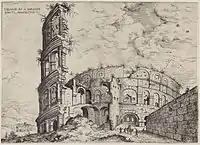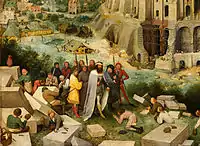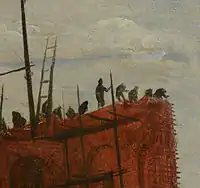The Tower of Babel (Bruegel)
The Tower of Babel was the subject of three paintings by Pieter Bruegel the Elder. The first, a miniature painted on ivory, was painted while Bruegel was in Rome and is now lost.[1][2] The two surviving paintings, often distinguished by the prefix "Great" and "Little", are in the Kunsthistorisches Museum, Vienna and the Museum Boijmans Van Beuningen in Rotterdam respectively. Both are oil paintings on wood panels.
| The (Great) Tower of Babel | |
|---|---|
_-_Google_Art_Project_-_edited.jpg.webp) | |
| Artist | Pieter Bruegel the Elder |
| Year | c. 1563 |
| Medium | oil on wood panel |
| Dimensions | 114 cm × 155 cm (45 in × 61 in) |
| Location | Kunsthistorisches Museum, Vienna |
| The (Little) Tower of Babel | |
|---|---|
_-_Google_Art_Project_-_edited.jpg.webp) | |
| Artist | Pieter Bruegel the Elder |
| Year | c. 1563 |
| Medium | oil on wood panel |
| Dimensions | 60 cm × 74.5 cm (24 in × 29.3 in) |
| Location | Museum Boijmans Van Beuningen, Rotterdam |
The Rotterdam painting is about half the size of the Vienna one. In broad terms they have exactly the same composition, but at a detailed level everything is different, whether in the architecture of the tower or in the sky and the landscape around the tower. The Vienna version has a group in the foreground, with the main figure presumably Nimrod, who was believed to have ordered the construction of the tower,[3] although the Bible does not actually say this. In Vienna the tower rises at the edge of a large city, but the Rotterdam tower is in open countryside.
The paintings depict the construction of the Tower of Babel, which, according to the Book of Genesis in the Bible, was built by a unified, monolingual humanity as a mark of their achievement and to prevent them from scattering: "Then they said, 'Come, let us build ourselves a city, and a tower with its top in the heavens, and let us make a name for ourselves; otherwise we shall be scattered abroad upon the face of the whole earth.'" (Genesis 11:4).
Description and analysis
Bruegel's depiction of the architecture of the tower, with its numerous arches and other examples of Roman engineering, is deliberately reminiscent of the Roman Colosseum,[4] which Christians of the time saw as a symbol of both hubris and persecution. Bruegel had visited Rome in 1552–1553. Back in Antwerp, he may have refreshed his memory of Rome with a series of engravings of the principal landmarks of the city made by the publisher of his own prints, Hieronymous Cock, for he incorporated details of Cock's engravings of Roman views in both surviving versions of the Tower of Babel.
The parallel of Rome and Babylon had a particular significance for Bruegel's contemporaries: Rome was the Eternal City, intended by the Caesars to last forever, and its decay and ruin were taken to symbolize the vanity and transience of earthly efforts.[3] The Tower was also symbolic of the religious turmoil between the Catholic Church (which at the time conducted all services in Latin) and the polyglot Protestant religion that was increasingly popular in the Netherlands. The subject may have had a specific topicality, as the famous Polyglot Bible in six languages, a landmark in Biblical scholarship, was published in Antwerp in 1566.[5] Although at first glance the tower appears to be a stable series of concentric pillars, upon closer examination it is apparent that none of the layers lies at a true horizontal. Rather the tower is built as an ascending spiral.
The workers in the painting have built the arches perpendicular to the slanted ground, thereby making them unstable, and a few arches can already be seen crumbling. The foundation and bottom layers of the tower had not been completed before the higher layers were constructed.

Lucas van Valckenborch, a contemporary of Bruegel's, also painted the Tower of Babel in the 1560s and later in his career, possibly after seeing Bruegel's depiction.[3] Both were part of a larger tradition of painting the tower during the 16th and 17th centuries.[6]
_-_Google_Art_Project.jpg.webp)
The story of the Tower of Babel (like that in The Suicide of Saul, Bruegel's only other painting with an Old Testament subject) was interpreted as an example of pride punished, and that is no doubt what Bruegel intended his painting to illustrate.[7] Moreover, the hectic activity of the engineers, masons and workmen points to a second moral: the futility of much human endeavour. Nimrod's doomed building was used to illustrate this meaning in Sebastian Brant's Ship of Fools.[8] Bruegel's knowledge of building procedures and techniques is considerable and correct in detail. The skill with which he has shown these activities recalls that his last commission, left unfinished at his death, was for a series of documentary paintings recording the digging of a canal linking Brussels and Antwerp.[9]
Both towers are shown partly-built with stone facings over a massive brick framework, a typical technique in Roman architecture, used in the Colosseum and other huge Roman buildings. Grand and formal architecture of this sort is not a usual interest of Bruegel in either paintings or drawings, although it was typical subject matter for many of his contemporaries.[10] Nadine Orenstein, in discussing his only known drawing of buildings in Rome, concludes from the details taken from the Colosseum in both Tower paintings that he "must" have recorded them in drawings on his visit ten years before, but given the easy availability of prints this does not seem conclusive.[11]
There are no surviving drawings that are studies for this or any other of Bruegel's paintings. This is despite indications that Bruegel did make use of preparatory studies. Both Tower versions are full of the type of details which are likely to have been worked out in sketches first.[12] Except for a lack of mountains, the paintings contain the main ingredients of the world landscape, a type of composition followed in many of Bruegel's earlier landscapes. The Vienna tower is built around a very steep small mountain, which can be seen protruding from the architecture at the centre near the ground and to the right higher up.
Provenance
On the Vienna painting, there is a stone block directly in front of the king which is signed and dated "Brvegel. FE. M.CCCCC.LXIII" (where Bruegel FE. is short for "Bruegel a fait en", French for "[painted] by Bruegel, in [1563]").[13] It was painted for the Antwerp banker Nicolaes Jonghelinck,[14] one of Bruegel's best patrons, who owned no fewer than 16 of his paintings.[15]
Gallery of details (Vienna version)
 Print of the Colosseum in Rome, published by Hieronymus Cock in 1551
Print of the Colosseum in Rome, published by Hieronymus Cock in 1551 The king and entourage visiting the builders. Bruegel's signature at bottom right.
The king and entourage visiting the builders. Bruegel's signature at bottom right. The peak above the clouds
The peak above the clouds Sillouetted bricklayers at the top level
Sillouetted bricklayers at the top level.jpg.webp) A crane
A crane_-_WGA3415.jpg.webp)
In popular culture
Artist Lothar Osterburg created a series of works influenced by The Tower of Babel under the title "Babel" (2015–7), which include photogravures, a stop-motion video, and a 28-foot sculpture installation built entirely from old books.[16][17]
| External video | |
|---|---|
References
- Orenstein, 6, one of the works belonging to Giulio Clovio
- Morra, Joanne (2007). "Utopia Lost: Allegory, Ruins and Pieter Bruegel's Towers of Babel". Art History. 30 (2): 200. doi:10.1111/j.1467-8365.2007.00538.x.
- "The Tower of Babel". Art and the Bible. Retrieved July 15, 2011.
- Malam, John (1999). Pieter Bruegel. Carolrhoda Books. pp. 15. ISBN 1-57505-366-7.
- Snyder, 502
- West, Andrew. "72 More Views of the Tower of Babel". BabelStone. Archived from the original on July 26, 2011. Retrieved July 15, 2011.
- Orenstein, 58
- This book's online text may be viewed at The Ship of Fools, Project Gutenberg. See also article by N. Collins, on Encyclopedia of Art Education Accessed 4 February 2012
- P. Allegretti, ibid.
- Snyder, 502; Orenstein, 96-97
- Orenstein, 96-97; see this British Museum page for another drawing of Roman ruins, perhaps the Colosseum, recently attributed to Bruegel
- Orenstein, 30-31
- Mohen, Jean-Pierre (1999). Sciences du patrimoine (Les): Identifier, conserver, restaurer. Odile Jacob. p. 13. ISBN 2-7381-0660-9. Retrieved 10 April 2020.
- "KHM Bilddatenbank". Archived from the original on November 3, 2012. Retrieved 2011-09-01.
- Orenstein, 8
- Cotter, Holland. "10 Galleries to Visit on the Lower East Side," The New York Times, April 16, 2015, p. C34. Retrieved August 10, 2020.
- Emba, Christine. "Critic's Notebook," The New Criterion, March 23, 2015. Retrieved August 10, 2020.
- "Bruegel's Tower of Babel". Smarthistory at Khan Academy. Archived from the original on November 6, 2014. Retrieved March 12, 2013.
- "The "Little" Tower of Babel". ARTtube. Retrieved March 19, 2013.
Sources
- Orenstein, Nadine M., ed. (2001). Pieter Bruegel the Elder: Drawings and Prints. The Metropolitan Museum of Art. ISBN 9780870999901. (full text free online)
- Snyder, James. Northern Renaissance Art, 1985, Harry N. Abrams, ISBN 0136235964
_-_Portrait_of_Pieter_Brueghel_(I)_-_1572_-_RP-P-1907-593_cropped.jpg.webp)